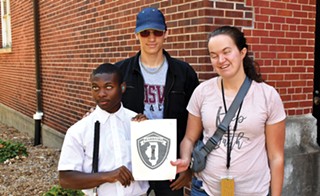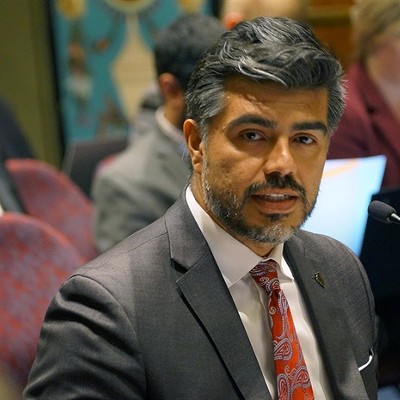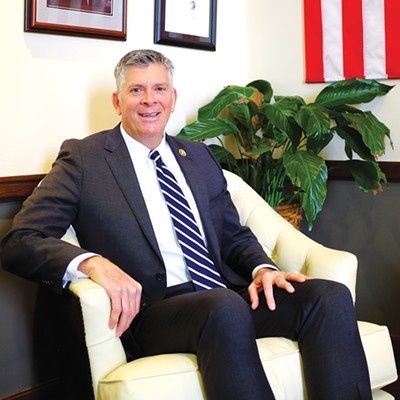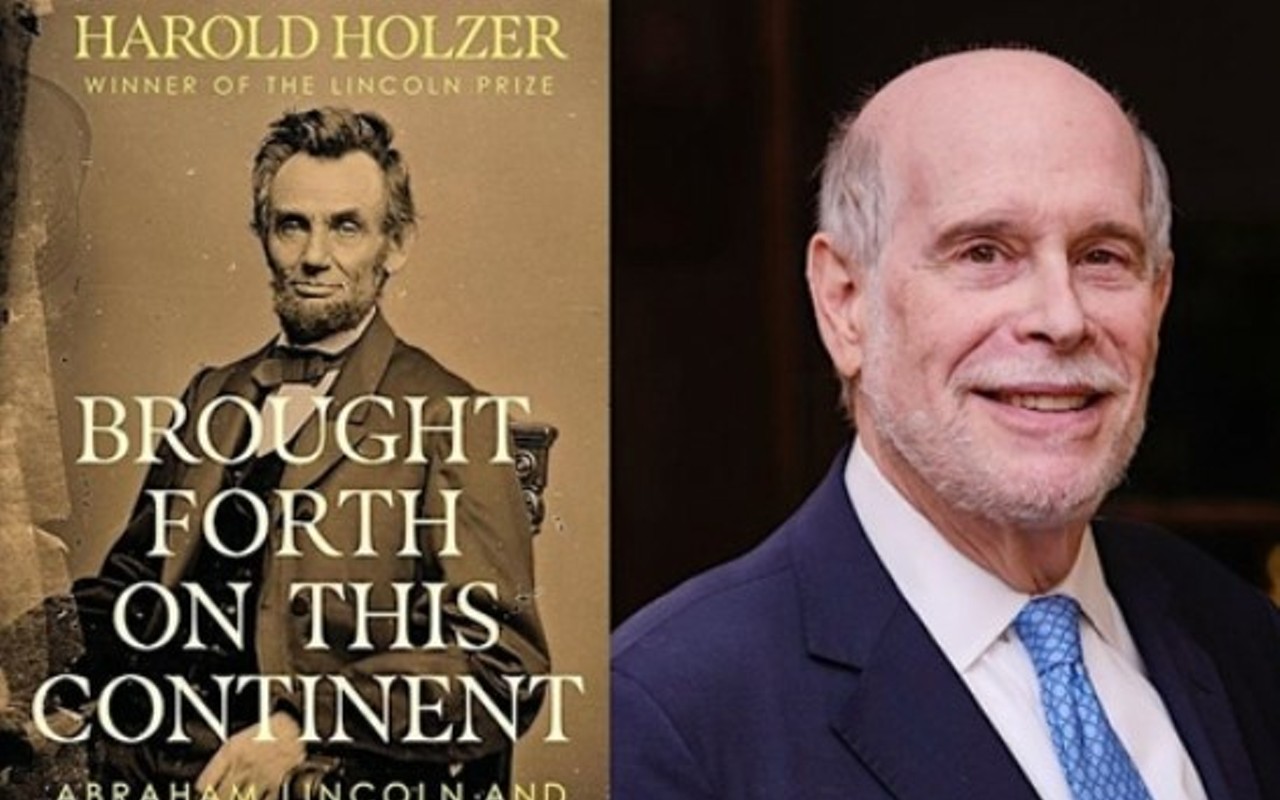The Illinois School for the Visually Impaired (ISVI) Warriors in Jacksonville just did something that other schools across the state and nation have done only grudgingly or not at all. The school has voluntarily and happily moved away from logos and mascots with Native American connotations.
Gone is ISVI's old Native American headdress logo, which has been replaced by a striking maroon and gold emblem that better represents how members of the student body feel about themselves and the school they attend. The new ISVI logo initiative is particularly noteworthy because it was driven by those same students, many of whom, because of their disabilities, have no idea what Native American iconography looks like.
The ISVI staff and students met with Native American representatives throughout the logo design process, culminating in a powwow and all-school assembly Oct. 25. Native American drummers pounded, singers chanted and a Native American "jingle dress" dancer waded into the crowd so the students could feel the garment that produced the mesmerizing sounds they heard during the dance performances.
Then, to the accompaniment of an all-school, pounding-on-cafeteria-table drum roll, three students pulled cords to officially show the new logo design for the first time.
The result is a new take on the ISVI Warriors, a logo that reflects the 175-year-old school's way of life where the students must fight harder for what they achieve. The process has also given the ISVI students and administration a new appreciation for the culture that was co-opted by the school's old, Native American feathered headdress logo.
In proclaiming Oct. 25, 2023, as ISVI Warriors Day, Gov. JB Pritzker paid homage to the ISVI students "who have decided to update their mascot to one that is inclusive of all cultures and represents their commitment to a better future."
"They are more than just a sports team logo."
The initiative to create a new ISVI logo began in 2007 but after several meetings that year and much spirited debate, students and alumni voted against moving away from their existing Native American headdress logo. That debate 16 years ago, a literal lifetime for many current ISVI students, paved the way for this fall's new logo unveiling.
"One of the biggest proponents for a new logo in 2007 almost exactly described the shield design that we have come up with today," said ISVI Superintendent Aimee Veith.
Veith assembled a team of 25 ISVI students of varying ages and they began discussions about a possible new logo in May of this year. The students eagerly took charge of the process, a big part of which involved welcoming Native American representatives to the school for discussions and demonstrations.
Twenty-year-old student L.T. Spears of Mattoon, who is completely blind, was part of the special ISVI logo committee.
"The old logo was out of date and it needed to represent more of us and our school as warriors than what the old logo depicted," Spears said. "We are not Native Americans here and we wanted it to represent the whole school and the state of Illinois."
Spears was pleased with the effect the Native American presentations had on the new logo discussions.
"I really enjoyed learning about their history and where they come from and why warriors are so important to them," Spears said. "I feel like they appreciated what we are doing because they are more than just a sports team logo, they are a whole living culture that goes back hundreds of years."
Sidney Horn is an 18-year-old from Effingham who was part of the student logo committee.
"They presented stories about Native American history, how strawberries were grown, the turtle in the river, all of these things that go on in Native American culture," Horn said. "They were deeply touched by what we are doing with our logo and how we are changing it."
Eighteen-year-old student Cameron Dempsey from Bloomington learned a lot through the Native American representatives' visits to ISVI.
"Our interactions have been very informative, and we learned how they feel about us changing the logo," Dempsey said. "Some students were a little concerned that we were changing our logo and what that might do to the school. We talked about how we needed something to fit everyone."
Andrew Johnson, a Cherokee, is a board member of the Chicago American Indian Community Collaborative and made several visits to the ISVI campus during the new logo design discussions. He hosted a series of assemblies to introduce students to Native American values, ideas and culture.
"When we heard that ISVI wanted to make this kind of change willingly, and it was supported by the parents and alumni, it made us feel really good about it," Johnson said. "Doing this makes them warriors in and of themselves."
"They are leaders who set an example that other schools could follow by showing respect to our Native American residents and putting together something that will fulfill more of their own values versus trying to adopt something from another culture," Johnson said. "They are doing this in a very non-selfish way. It has made us very, very proud of the direction they took, the courage they displayed and where they took the initiative to do this."
"We all came together and designed it as a school."
While the ISVI students were learning about Native American culture, Superintendent Veith and the Illinois Department of Human Services, which administers the school, approved the use of a consulting firm to listen to the students' ideas and come up with some logo design choices.
L.T. Spears and his student colleagues discussed several ideas for what might be included in the new logo. A depiction of the Perkins Brailler, a Braille typewriter invented by former ISVI Superintendent Frank Hall, was one possibility. Others included a goal ball, from a team sport played by visually impaired athletes, and crossed white wayfinding canes of the type used by the visually impaired.
"I liked the one with the canes, it suits our school more and it's a great emblem for our school," Spears said. "The white canes help us, a lot of us walk around with our white canes to find obstacles and get to places."
Several ideas were suggested for graphics to represent the city of Jacksonville where ISVI is located. These included a Ferris Wheel, because the amusement rides are still manufactured in the city, and elm tree leaves, since Jacksonville was once known as the Elm City for its lush canopies of the huge shade trees.
The consulting firm returned with several draft logo designs incorporating the students' ideas. The designs were presented as color graphics for the students who have some sight, and as a "picture in a flash," where the design elements are raised and have a different tactile feel from the page on which they are printed.
"The tactile impression of the logo is important because the ones who need to feel it can't actually see it with their own eyes," said logo committee member Sidney Horn. "So, we touch, feel and explore it and that's how we see it."
Horn has some color and light contrast perception and can see shadows. All the potential logo designs were presented in the school's traditional maroon and gold colors because people with Horn's type of impairment can more easily perceive the contrast between those two colors.
"I really liked the name of Illinois written across the center of one design and I liked the crossed canes on another design," Horn said.
All of the initial logo designs had issues for ISVI's student body. Several of the designs were simply too busy for the students who rely completely on Braille. The letters spelling "Warriors" on some designs were too close together for the students to read.
None of the initial logo designs were chosen, but the students' feedback, and some homegrown design ideas from the ISVI health center director, gave the consulting firm the additional input they needed.
The final logo design features the outline of a shield with "Warriors" spelled out in a ribbon flourish near the top. Inside the shield is an outline of the state of Illinois. A capital "I" is in the center, and that letter incorporates two raised dots that are the letter "I" in Braille.
"A lot of us read Braille and having the Braille dots in the 'I' suits our school," said committee member Cameron Dempsey, who has some sight. "At this school they actually want to hear the students' voices and the students' opinions. We put our voice in and give our input on how we feel about this new logo."
Fellow student Spears also appreciated being part of the logo committee.
"I was really impressed that the administrative staff let the students be a huge part of this because there are times when one or two administrators are like 'OK, we're going to do this and everyone is just going to have to deal with it,'" Spears said. "But I really enjoy how we all came together and designed it as a school and made a really good logo that represents the whole school."
"They are Warriors for each other and with each other."
Illinois School for the Visually Impaired students, teachers and staff still call themselves the Warriors. But along with the new logo, the moniker means something different that the students feel does not usurp Native American culture.
"When I think of a warrior I think of a strong, courageous fighter," student Sidney Horn said.
Fellow student Cameron Dempsey thinks an ISVI Warrior is "brave, but also accepting. We accept a lot of people here," he said. "We know that even if somebody tells us we can't do something because we are visually impaired, we can do just as much as people with sight."
Superintendent Aimee Veith has recognized the ISVI Warrior mindset throughout the entire logo design process.
"I listened to a fourth grader named Liam and how he used his voice at nine years old to tell why he is a warrior," Veith said. "While he appreciates the fact that the warrior headdress is Native American and that's cool too, that's not who he is. He is part of this school where they are Warriors for each other and with each other."
L.T. Spears hopes that when people encounter the new Warriors logo, they will get a much clearer image of what ISVI is all about.
"A warrior is someone who perseveres through hard times, someone that doesn't back down to adversity or challenges," Spears said. "I hope it reaches more people and shows them that we are a blind school, and although we are visually impaired, we can do everything that a sighted person can do and sometimes more."
Illinois Department of Human Services Director Dulce Quintero, who attended the Oct. 25 logo unveiling, told the ISVI students that they personify the term "warrior."
"You have confronted history and made changes for the better. The best way to help people is to listen and learn from them, and that is just what you did," Quintero said. "You have built bridges of understanding and you have created a new path forward."
























